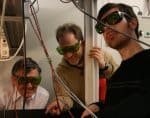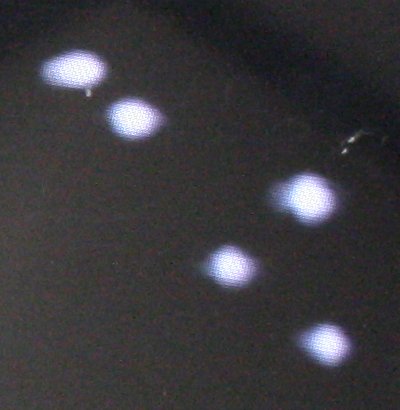
Physicists in the UK and Germany have harnessed the curious properties of soliton waves to create a new type of semiconductor laser that can be switched on and off using light pulses.
The team believe that this “cavity soliton laser” could play an important role in “all-optical” telecoms systems, in which data are switched and routed without the need to convert light pulses into electrical signals and back again — processes that can slow-down communications and create large amounts of waste heat.
Based on commercial device
The device is based on a vertical-cavity surface-emitting laser (VCSEL), which is used in a wide range of applications including optical telecoms. The VCSEL was built by the German firm ULM Photonics and the final system was assembled and characterized by Thorsten Ackemann and colleagues at the University of Strathclyde in the UK (Phys Rev Lett 100 013907).
A VCSEL comprises an optical “cavity” of a solid semiconductor material such as indium gallium arsenide (InGaAs) that is sandwiched between two special “mirrors” that are made of multiple layers of other semiconductors. Normally, a current is injected into the optical cavity causing the semiconductor to emit light. The mirrors reflect the light back and forth across the cavity, which causes more light to be emitted, as in a conventional laser. Some of this laser light is allowed escape through one of the mirrors.
Instead of operating the laser in this way, the team put a smaller current through the device such that it did not emit laser light. The device is coupled to an external optical cavity containing a diffraction grating, which defines the frequency of the light reflected within the external cavity. This frequency is deliberately offset slightly from the frequency of light within the free-running VCSEL.
The team then fired a pulse from an external laser at a small spot (12 µm diameter) in the VCSEL cavity. This changes the index of refraction at that spot, causing the resonant frequency of the VCSEL in the region of the spot to become the same as a resonant frequency of the external cavity.
This causes a bright spot of light to form in that region of the VCSEL. The spot is called a soliton because it is a solitary wave that confines itself to the area where the laser struck and does not spread out into the rest of the cavity. This occurs because the soliton light continues to modify the local refractive index and the step-change in refractive index outside of the soliton region prevents light from moving into the rest of the material.
Ensemble of microlasers
The intensity of the light builds up rapidly because it is confined to a small area and a small laser forms at that location. The laser can then be switched off by firing a second laser pulse at the region, which further modifies the index of refraction and destroys the soliton. This procedure can be repeated at multiple locations within the VCSEL leading to an ensemble of “microlasers”.
The present device emits near-infrared light with a wavelength of 980 nm, whereas telecoms devices operate at wavelengths greater than about 1.2 µm. Ackemann told physicsworld.com that there is in principle no obstacle to the realization of similar cavity soliton lasers that operate at telecoms wavelengths and described this as a “challenge for the future”.
The team are now working on miniaturizing the device, which currently has an external cavity that is 50 cm in length. Ackemann is confident that this can be reduced to several centimetres without too much trouble it may be possible to create the entire laser on a single chip.
Delaying light
Last month, the Strathclyde group and European colleagues showed that a similar cavity soliton device can be used to delay the propagation of light pulses — another important function that could be used in telecoms devices (Appl Phys Lett 92 011101). Ackemann said that the team are also trying to build cavity soliton laser devices that can both switch and delay light.
Progress will rely not least on achieving high quality growth of the VCSEL structures. The devices were fabricated by molecular beam epitaxy — a technique that is used to make semiconductor lasers for commercial use. Ackemann described the process for advancing the cavity soliton lasers as “difficult but possible”.



